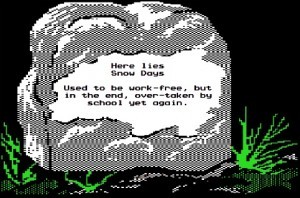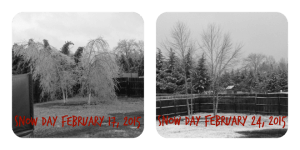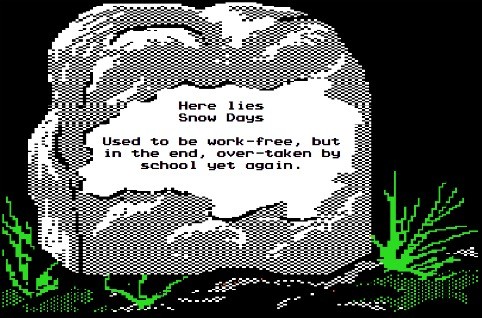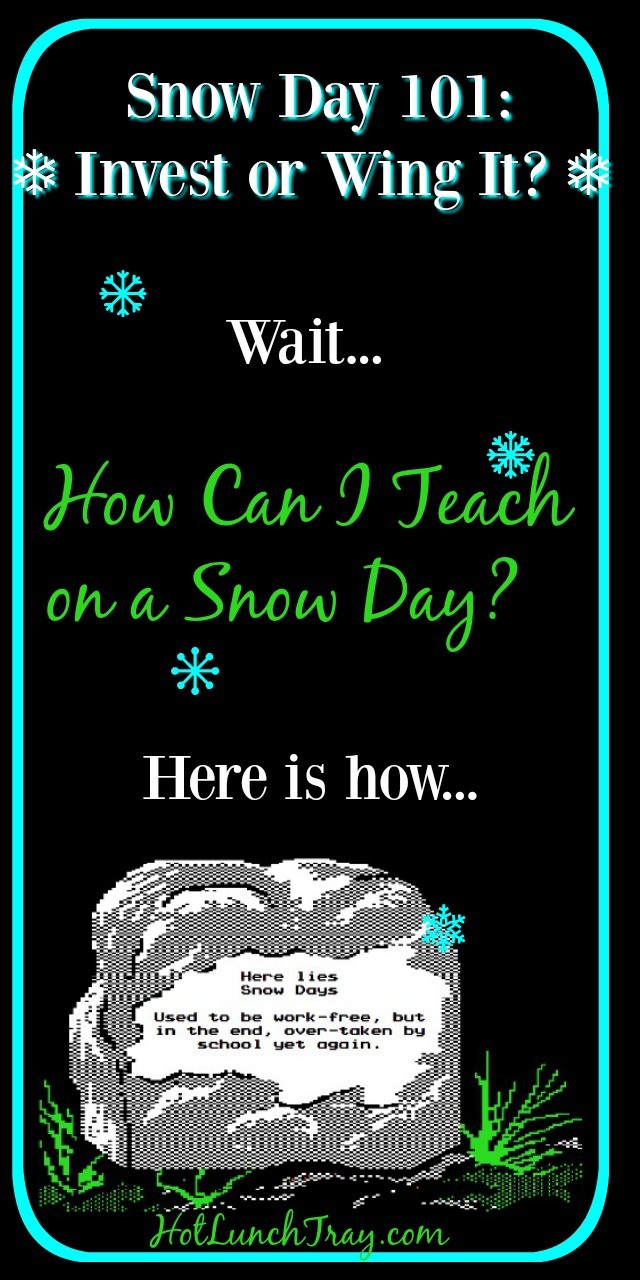I have fond memories of listening to the snowplow rumble by my house around 6:00 AM and fancying I could tell by the sounds it made if school would be cancelled. The seconds it took me to jump from my warm bed and peek around the window shade was anticipation filled, all two steps. I didn’t dare say “Snow Day” out loud before I looked for myself. And that was only back in early 2000 as a teacher!

image credit: https://www.oregontrailtombstone.com/
Those days are in the past. Technology is ubiquitous and the expectation of schools to proficiently teach with technology is growing. With an increase in the means of asynchronous schooling comes the sunset of the Snow Day as we knew it. Since 2013 a convergence of weather events, technology, and the will to work through those weather events have all conspired to end school-free Snow Days. The last couple years had many of what we used to call Snow Days, but they don’t quite feel the same.
❄Is Snow Day Success out There?
ISTE, International Society for Technology in Education, shared resources mean to help districts prepare for successful virtual school days. One particularly useful resource is the webinar Online Learning for Inclement Weather containing success stories. The links within the chat box of this webinar are still active and offer artifacts which districts might repurpose.
Two plans in the webinar seemed highly effective and considerate from the teacher and home perspective. Note how these two ideas allow teachers to intentionally structure how they enter this previously unfamiliar world of asynchronous teaching:
Example One
Kay Gentsch of Bishop Lynch High School in Dallas, Texas trained teachers for “Electronic Days” in advance via her DE-ICE preparatory class.
D – Determine Lesson Essentials. Not class time plus homework, less is more!
E – Execute the Content! Create and upload.
I – Inform your Students (parents too)
C – Checking In – a variety of approaches for interaction
E – Expectations – specific due dates, plans for no power/Internet
This program put teachers through the practice of constructing learning opportunities to contain five, pre-identified components in advance of weather. Each teacher assembled: an announcement or email about the Snow Day, a personally created instructional video, an instructional video from another source, an activity to check understanding of the video, and then an assignment. This format explained to teachers what they needed to provide and an expected format for students and parents working from home.
This was a powerful idea because the teachers all had experience, and a template to follow by the time the weather caused a disruption in face-to-face instruction.
Example Two
Holly Stachler of Yorktown Community Schools in Yorktown, Indiana shares how she led her district to make up snow days in advance of high-stakes testing versus adding token minutes to school days. The strength of this effort was the innovative use of non-school time to accomplish exposure to curriculum in advance of high stakes testing. The window for completion of work was between end of school Friday and start of day Monday, so this truly was outside regular school time.
Holly also led her district in scaffolding the expectations for teachers before and during the online learning days. She provided scripts for classroom announcements, mass communications to stakeholders, and provided meetings and technical support as needed throughout the experience. By thinking through these details in advance Holly allowed her teachers to concentrate on content and execution of the online learning days.
❄What’s at Stake?
No one plans to do any schooling wrong, but when teachers lack scaffolding for successful asynchronous teaching – struggle is predictable. Teachers “try out” blended learning in their classroom. However, that is not equal to teachers “trying out” online learning during a weather event. The stress alone impacts the learning. New strategies a teacher attempts in the classroom are controlled experiments; a teacher intervenes early and often, works with small groups, and the message home is formed during the class period. New strategies a teacher attempts online without prior experience are less informed, less perfected. Kay Gentsch addresses lack of common experience by practicing creating the content before an actual event, and gives guidelines of components for any future constructed online learning experiences. The first investments in future Snow Days should be teacher professional development in blended learning best practices. A secondary professional development should be around features of any district asynchronous learning platforms. With these ideas, teachers confidently tackle trying new strategies in their classrooms and start preparing for the next Snow Day.
❄Continuity of Experience
The Snow Day experience should be as similar to daily instruction as possible to continue the learning environment. Delivery which varies highly from the face-to-face instruction will confuse students and not serve teachers as recovered classroom time. With blended learning elements already in class, a teacher can adjust closer toward online instruction format with fewer adjustments. The continuity of the classroom environment is not lost. If face-to-face daily instruction has no blended facets, the teacher is better to just send home augmented paper assignments. It is more work to try to jump to online without student prior experience.
Preparation
The Snow Day experience should flow within the context of the current learning in the classroom. For this reason it is likely that there is preparation immediately before posting an online unit. This preparation is similar to the reciprocal teaching model and no more than daily preparation plus publishing online. By definition it cannot be prepared far in advance. Teachers should not utilize static “Snow Day lessons.” If the content is meaningful it should be covered at the natural point in the class. If the content is not relevant it should not be used as a filler activity because of its electronic format. So the skill of constructing online, or converting existing blended, content requires practice. It must be cultivated within our teachers in advance of weather events.
How Much Work?
An element which both Kay and Holly alluded to was the amount of work for students and teachers. Kay points out that online instruction should not be the same minutes as face-to-face meetings plus homework. Holly offered that different levels of students should expect a specific number of hours of work. Holly’s guidelines promote teamwork, especially in grades where students change classes, an opportunity for interdisciplinary units/projects. Teachers could also deconstruct whole group activities to smaller components for the students complete building up to the next face-to-face session. Ultimately, it sustains the value of online learning if students feel as if they had enough time to complete meaningful assignments thoroughly. If assignments appear unmeaningful students may not complete them at all; that might create more make-up/work scenarios for teachers and students alike. A quick or forced conversion to online teaching or learning does not result in appropriate time on meaningful tasks. Blended learning is “pre-work” for teachers, highlighting how digital content is chunked and paced online versus in class or on worksheets. Teachers need to practice pacing/chunking to predict/adjust the rate of completion of Snow Day work.
How To Complete?
While Holly was purposeful not to offer completion opportunities during regular school days, consider if your situation has to be so rigid. Due Dates do not need to follow the typical school schedule when delivery is asynchronous. Assignment due dates can layer over existing daily due dates; dates for asynchronous activities could last a week while your face-to-face due dates remain daily.
The final issue in continuity of experience is the question of access. If your school provides students with devices, this is not an issue. If you are a Bring Your Own Device (BYOD) school, you may already know which students need help. Otherwise you will need to plan in advance how to deliver online content to your students. Many classrooms which are not 1:1 experience a shift when school moves to the home. If access is an issue consider offering access at one central location for an extended period before the due date as Holly did for Yorktown.
❄Not Every Snow Day is Created Equal

Some weather events are more serious than others. Pictured are the two events in my district last year. One event took out power for days. The other involved only snow for a day or two. During the event without power online interaction was not possible. Stress is heightened, working from home was not appropriate; it could not be effective. Immediate needs need to be addressed before worrying about school. During the second event, school from home was more appropriate for teachers and students.
Sometimes the work happens long after the snow is gone. Holly’s example are make-up days. These have advantages such as predictable timelines and the ability to plan for support. Instead of individual teachers scrambling to be post their isolated content in time, teachers could work together to make sure all teachers post high quality, engaging, meaningful work.
❄It isn’t Snowing for You?
Eventually you may experience the opportunity to teach during an inclement weather day. Will you be prepared or will you start considering these thoughts at that time? Consider this your weather advisory.







2020-02-21 at 11:46 am
Such a great idea to use technology on a Snow Day when possible. There are so many options out there!